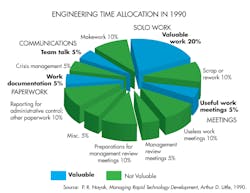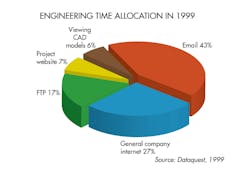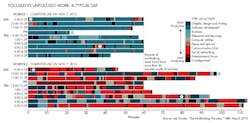The Importance of an Engineering Work Ethic
Download this article in PDF format.
Monitoring and measuring how engineers spent their work day was considered normal and to be expected during the 20th century. Time studies were numerous. In the 1990s, the relationship between corporations and workers began to change. Cell phones had become widespread, email replaced faxing, internet availability was accelerating, and the growth of globalization necessitated work in multiple time zones—from home as required. Reciprocally, employees had become empowered with personal systems and no longer needed to be hesitant to use company systems for personal items during the work day. If an employer was asking for time “after hours,” then it was only fair for the employee to have more flexibility during “work hours.” And, here we are.
Historical Engineering Productivity: Booz-Allen, A. T. Kearney, and Arthur D. Little were famous among Methods Time Measurement (MTM) and time studies companies (see figure below). Their industrial engineers would invade a company and several months later a fairly exact time analysis report gave management X-ray vision into what was happening in individual departments and in aggregate. Knowing their department would be measured at some point helped “employee hygiene” to stay focused on the activities companies expected of them. The specificity also enabled good two-way capacity management. Employees used management’s own figures to successfully push back on overloading and resource availability.
Report after report showed that engineers’ “actual productive time spent” to invent, innovate, improve, or produce the outputs expected of them or their department was 35% to 40% of the work day. At street level, if an engineer was juggling three projects, each project received 10% to 12% of an engineer’s time each day to create for the project.
Changing Engineering Productivity: In the 1990s the penetration of automated engineering tools went from 10% for 3D Solids Modeling and EDA to near 90%. Just about all of an engineer’s productive work was now on computers. It was much harder for management and time specialists to measure and track an engineer’s time. Analysts would look at the mainframe and server logs to assess time allocation and activity levels (see figure below). For a few years, the MTM analysts tried peering over the shoulder of engineers to get more detail. After a number of complaints, management realized it had to find another way. The choices were few, however.
Globalization also had its effect. Outsourcing led to many activities falling outside the scrutiny of analysts. Phone calls and communications, once considered overhead, now became part of valuable work. Societal advances left many corporations less able to drive innovation. We have all seen the figures for the past dozen years.
A Multitasking Panacea: By 2005, just about everything during the work day was electronic. The world was operating 24/7-365. Employees had greater autonomy than at any point in history. Personal calls, emails, and texts came in during the work day and work items arrived at home. Multitasking had arrived. Unexpectedly, the importance of personal responsibility and ethic to meet one’s commitments was now greater than ever.
Multitasking is not a natural human trait. In a few hundred years, natural evolution may improve human abilities. Until then, being cognizant of multitasking is necessary. In 2007, an ABC Evening News broadcast cited, “People are interrupted once every 10.5 minutes. It takes 23 minutes to regain your train of thought. People lose 2.1 hours each day to multitasking.”
A great paper by Mark, Gloria, et al., in 2005, entitled “No Task Left Behind,” indicated that a person juggled 12 work spheres each day and 57% of the work got interrupted (see figure below). As a result, 23% of the work to be done that day got pushed to the next day and beyond. That was the case a dozen years ago.
Strive for Focused Work: The multitasking wave affects engineers of all generations. Already, we exert some level of control. There are facts that indicate that both employers and employees might benefit by doing even more. When focused work is contrasted with unfocused work, the difference is 277 vs. 496 mental switches each day (The Multitasking Paradox, HBR March 2013). Worker productivity is 85% vs. 33% (see figure below). The work day is shorter and has less mental cycles resulting in better productivity for an employer with less wear and tear on an engineer. Attempting to maximize work ethic discipline each day likely benefits everyone.
About the Author
Bradford Goldense
Contributing Technical Expert
Bradford L. Goldense is founder and president of Goldense Group, Inc. [GGI] (www.goldensegroupinc.com), a consulting, market research, and education firm focused on business and technology management strategies and practices for product creation, development, and commercialization. He has been an adjunct faculty member of the graduate engineering school at Tufts University's Gordon Institute for 19 years. Goldense is a Certified New Product Development Professional [NPDP], a Certified Manufacturing Engineer [CMfgE], a Certified Computer Professional [CCP], and is Certified In Production & Inventory Management [CPIM]. He holds over 200 registered copyrights and is a recognized subject-matter expert, including appearances on PBS and CNBC. He has consulted to over 250 companies and over 750 manufacturing locations on four continents since founding GGI in 1986. Goldense holds an MBA in Accounting from the Cornell Johnson School and a BSCE from Brown University. For more information, please see Brad's LinkedIn profile or visit GGI's home page.




